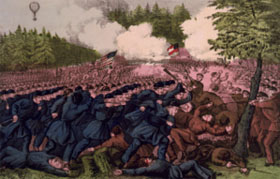


| |||||||||||||||||||||
|
The Union Army of the Potomac, crawling up the Virginia peninsula between the York and James Rivers, reached the outskirts of Richmond during the final days of May 1862. Maj. Gen. George McClellan divided his Union army, placing 2 corps south of the Chickahominy River and 3 to the north. Though this was a dangerous disposition, McClellan argued that his northern wing could hook up with Maj. Gen. Irvin McDowell's command, expected to be moving south from Fredricksburg.
On May 30, Gen. Joseph E. Johnston seized the opportunity, rapidly devising a complicated plan of attack against McClellan's 2 isolated corps, the III and IV, under Maj. Gens. Samuel P. Heintzelman and Erasmus D. Keyes, respectively.
Johnson's scheme assigned 2/3 of his army to the attack. While 2 divisions screened along the line north of the river, 3 Confederate commands were ordered to charge from 3 seperate directions. Maj. Gen. James Longstreet's corps, reinforced by Brig. Gen. William C. Whiting's division, was directed to envelop Keye's right flank at Seven Pines by the Nine Mile road. Maj. Gen. Daniel Hill's division was ordered to attack along the Williamsburg road, while Maj. Gen. Benjamin Huger's division, protecting the Confederate right, advanced along the Charles City road.
The intricate battle plan floundered immediately on the morning of May 31. Johnson had issued verbal, not written, orders and confusion resulted as Longstreet marched alomg the roads assigned to Hill and Huger. Longstreet's error entangled the Confederate commands, delaying the attack for several hours. The battle finally began at 1:00 P.M. when Hill charged alone at Seven Pines.
Hill's brigades stormed through the swampy, wooded terrain, pushing back Keye's Federals. Keye's subordinates shifted troops while Heintzelman sent reinforcements. The Confederates crushed the Union right, forcing some Federals north to Fair Oaks. Late in the day, one of Longstreet's brigades bolstered Hill's forces and the Confederates swept forward again. The Union troops withdrew to a 3rd line after their counterattack was repulsed. By 6:00 P.M., the action had subsided at Seven Pines.
At Fair Oaks, meanwhile, Whiting finally charged at about 4:00 P.M. His assault struck elements of the Union II Corps, whose commander, Maj. Gen. Edwin V. Sumner, had brought them across the flooded Chickahominy less than an hour before. Sumner's soldiers repulsed the attack and, in the twilight, Johnson, riding along the lines, fell severely wounded. Maj. Gen. Gustavus W. Smith temporarily replaced him, ordering a renewal of attacks at dawn.
Longstreet, as on the day before, failed his assignmenton June 1. He attacked tentativelywith only 2 brigades, believing that the Federals were about to assault him. The weak Confederate charge was easily repulsed and no other serious action occurred. Gen. Robert E. Lee, formally replacing Johnson, ordered a withdrawal to the original positions at 2:00 P.M.
McClellan's soldiers prevented a possible disaster, holding the feild in a tactical victory. Both sides claimed victory, but if this was the best the South could do, they were doomed: McClellan would take Richmond by siege. Each army had nearly 42,000 troops engaged. The Battle of Seven Pines had significant results, however. The "mangled corpses" unnerved McClellan, reinforcing his natural caution to avoid battle. Johnson's fall elevated Lee to command, a turning point in Confederate fortunes in Virginia.
